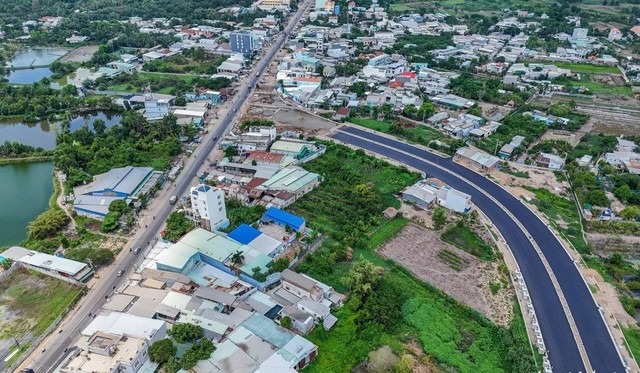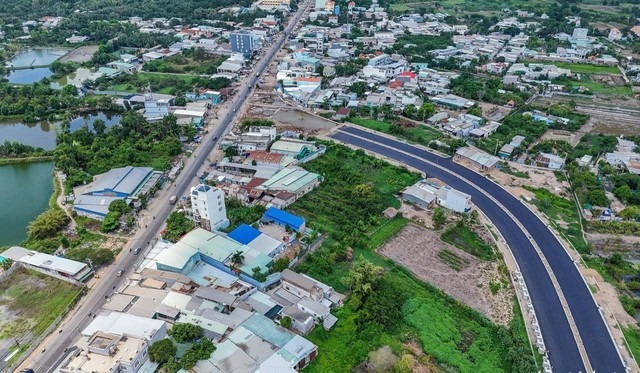A series of infrastructure projects worth thousands of billions of VND are being planned and implemented to connect Ho Chi Minh City and Long An province. Regarding the Vo Van Kiet road extension project to Duc Hoa, the Ho Chi Minh City People’s Committee has instructed the Management Authority for Traffic Work Construction to urgently develop a pre-feasibility study report.
The existing Vo Van Kiet road will be extended by 14.6 km, starting from the intersection with the National Highway 1 overpass (on the existing Vo Van Kiet road) and ending at the border with Long An province (coinciding with the starting point of the DT.823D project).
The 14.6km long route is divided into three main sections. Specifically, Section 1 runs from the National Highway 1 overpass to the Tan Tao – Cho Dem road (Vo Tran Chi street), spanning 2.7km. Section 2, from Tan Tao – Cho Dem to the intersection with the Ring Road 3, measures 6.6km in length. As for Section 3, it stretches 5.3km from Ring Road 3 to the border with Long An, including a 1.68km section that passes through the Sing Viet urban area.
The Vo Van Kiet extension is designed as an urban artery, 60m wide, with a speed limit of up to 80km/h. Along the route, six river crossings (such as An Ha, Lang Le, Bau Co, etc.) and an interchange with Ring Road 3, complete with overpasses, tunnels, and a system of ramps, will be constructed.
The total investment for the entire route is estimated at VND 19,397 billion, including VND 12,800 billion for land clearance costs and over VND 3,769 billion for construction expenses… The project is expected to commence in the first quarter of 2026.
National Highway 50B is a completely new transportation route, designed to enhance connectivity between Ho Chi Minh City and two Mekong Delta provinces: Long An and Tien Giang.

QL50B passes through 3 localities: Ho Chi Minh City – Tan Tru (Long An) and Tien Giang.
This 55km long route includes a 5.8km section in Ho Chi Minh City, beginning at Pham Hung street and traversing Binh Chanh and Nha Be districts. The project is designed with six lanes and a cross-section width of 40m, with an estimated total investment of VND 5,300 billion.
This route has been integrated into the adjusted master plan for Ho Chi Minh City until 2040, with a vision towards 2060, and included in the medium-term public investment plan for the 2026-2030 period.
Upon completion, the project will play a crucial role in alleviating traffic congestion on the existing National Highways 1 and 50, facilitating transportation to the Mekong Delta provinces, and contributing to the development of a strategic transportation corridor.
In early April 2025, the Ho Chi Minh City Traffic Work Construction Project Management Board proposed allocating more than VND 5,200 billion for the preparation of the new Westward Road project, connecting Ring Road 2 to Vinh Loc Industrial Park (Binh Chanh) and DT.823D road (Long An). With a length of 9.9 km and a scale of 6-8 lanes, the project is expected to be implemented during the 2026-2030 period.
Once completed, this route will serve as an important cross-city axis, connecting Ring Road 2 of Ho Chi Minh City with its Ring Roads 3 and 4, reducing traffic congestion, and promoting the development of industrial parks. Moreover, it will shorten the travel distance from Long An to Ho Chi Minh City, providing a more direct route to the city center.
The infrastructure landscape connecting Ho Chi Minh City with Long An and Tay Ninh also includes the Ho Chi Minh City – Moc Bai Expressway. Phase 1 of this project covers a length of nearly 51 km, featuring four lanes and a total capital of over VND 19,600 billion. The construction of the expressway’s main route is scheduled to begin in January 2026, while the ground-level road and overpass will kick off on September 2, 2025, with the entire project expected to be completed by the end of 2027.
| Route | Preparation (2025) | Commencement | Expected Completion |
|---|---|---|---|
| Vo Van Kiet Extension | Submission to People’s Council, investment dossier, land clearance | 1st quarter of 2026 | 2026-2030 |
| New Westward Road | Land clearance, project completion, PPP | After 2026 | 2026-2030 |
| National Highway 50B | Planning adjustments, project establishment | — | 2030 and beyond |
| Ho Chi Minh City – Moc Bai Expressway | Boundary staking, land clearance, approval of resettlement | September 2, 2025 + January 2026 | End of 2027 |
The completion of these projects will reshape the transportation infrastructure in the west and northwest of Ho Chi Minh City, establishing inter-provincial connections to Long An, Tien Giang, and Tay Ninh. This will not only alleviate traffic congestion but also open up opportunities for economic development, logistics, new urban areas, and shape the landscape of the key southern economic region.
Crafting Compelling Compensation: A Post-Merger Policy Proposal
“There is a pressing need to expedite the reform of wage policies post-merger. With an increased workload, a broader scope of management, and greater responsibility for the personnel at the commune level, we must accelerate these reforms,” urged a delegate of the National Assembly.
The Race for the Finish Line: Unveiling the $435 Million Mega-Project in Ho Chi Minh City
After years of delays, the $433 million tidal flood control project remains shrouded in uncertainty, leading to a waste of resources and a decline in investment efficiency.
No Disruption to Land Procedures During Trial Operations
On the morning of June 11, the atmosphere at the Gò Vấp District People’s Committee Office in Ho Chi Minh City was bustling yet efficient. Despite a steady stream of citizens seeking administrative services, the staff seamlessly processed their requests with remarkable speed. While some counters, such as those for business licenses, civil registry, and labor issues, swiftly dispatched their tasks within minutes, the land and property records counter experienced a slight delay in handling their documents.





















